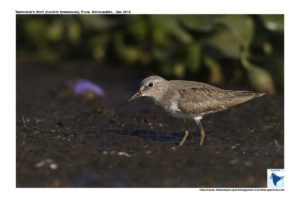Temmincks Stint

Temminck’s Stint Calidris temminckii
Etymology:
- Calidris : Greek word for grey-coloured waterside bird mentioned by Aristotle
- Temminckii : Dutch ornithologist Coenraad Jacob Temminck (1778–1858)
Vernacular names: Hindi: Chhotapan lowwa, Guj: Ujalapagkhi chdiyo, Ta: Manjakaal kosuullan, Mal: Temminkimana loothi, Mar: Temink Cha Tilawa/ chi tutari
Distribution in India: Widespread winter visitor in India
Description: Size of 13-15 cm.It is small, short-legged stint with broad white sides to tail and rump, upperparts range from dull grey to olive-brown, with variable patches of black-brown, dull rufous and grey; head and breast grey-brown; breast heavily streaked brown; white on chin, throat and belly. Both sexes similar and the female is slightly larger, in wing, bill and tarsus length, as well as body mass. Non-breeding adult has plain dark grey upperparts and head; breast uniform pale grey-brown; chin and throat white. The juvenile is like non-breeding adult, but upper part feathers are brown-grey with dark sub-terminal band and buff fringes.
Habitat: It is found during breeding in typical tundra, shrub tundra and floodplains in forest tundra up to 1200 m; on level ground clear of vegetation, or covered with short grass interspersed by patches of shrubs. In non-breeding season, variety of wetland types, preferably inland freshwater sites like flood lands, irrigated fields, sewage farms and more or less densely vegetated wetlands; more rarely on tidal mudflats, saltmarshes and coastal lagoons. It avoids open coast.
Food Habits: It eats invertebrates; during breeding season primarily larval and adult Diptera and small beetles; after breeding also ants, Hymenoptera, water-bugs, annelids, small molluscs, crustaceans, freshwater mites and plant material. It feeds by rapid pecking actions but doesn’t probe.
Breeding Habits: They breed in Arctic Europe and Asia in June-July. Successive bigamy by both sexes, occasionally with third clutch, while pair-bond typically lasts only 1 week, but some males (which do not incubate) actively pursue extra-pair copulation and perhaps do this in most seasons, being specialist ‘non-incubators’. Nest is on ground in open or low vegetation, lined with plant stems and leaves.They lay a clutch of 2-4 eggs. The second clutch started 2–9 days after first; each nest cared for by one parent, first by male; in case of three clutches, second cared for by another male, third cared for by female. The incubation period is 21–22 days, starting with last egg. The fledging happens in 15–18 days.